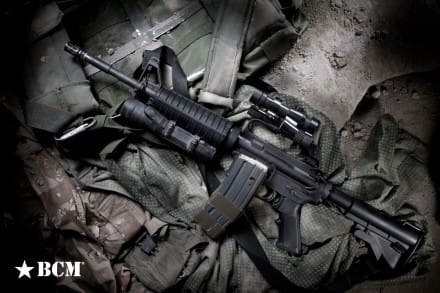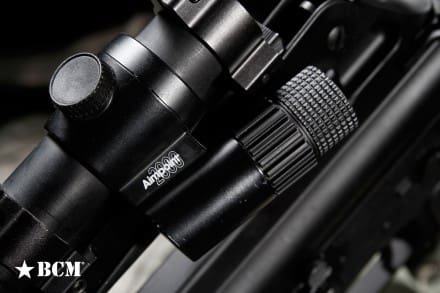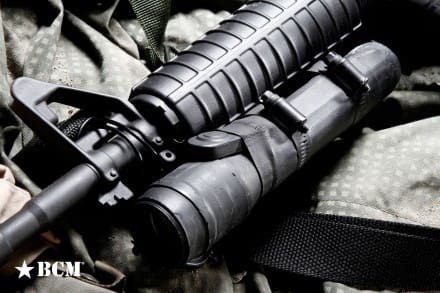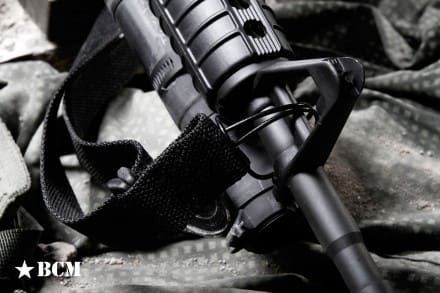We recently published a photo from Larry Vickers that showed a rebuild of the carbine he used in the Model Prison Raid during the Invasion of Panama. In chapter 1 of the new web series BCM Gunfighter History, LAV gives the rest of the story behind that gun.
BY LARRY VICKERS
When I checked into the Operator Training Course (OTC) at 1st SFOD-Delta in late 1988, I was issued a brand new, straight from Colt, base carbine. The official Colt designation was Model 723, but we simply referred to those carbines as CAR-15s. To be honest, I was initially very unimpressed.
In OTC, we completed a basic rifle marksmanship class with accurized M14s and after shooting those guns, with excellent triggers, the Mil-Spec trigger on my CAR-15 was terrible. I also distinctly remember only one failure-to-feed malfunction in OTC with my CAR-15; but after that, I honestly do not remember a single stoppage the entire time I used that weapon. Colt was building some of the best carbines in their history at that time and mine was a prime example. It was an excellent small-arm that performed for me its entire service life.
This CAR-15 was the first individual weapon I had ever used with a red dot sight; in this case an Aimpoint 2000. Experience with it made me realize that target engagements with a red dot optic vs iron sights were much quicker and more accurate across the spectrum from daylight to low light. This started my relationship with Aimpoint that continues to this day. They are quite simply the best red dot optics, in my opinion.
In addition, a waterproof SCUBA dive flashlight painted black was installed underneath the bottom handguard via hose clamps, and then our commo guys wired the flashlight for push button activation. It worked well for the intended purposes but they were replaced in short order once Surefire 6P flashlights came online. 1988 was a long time before Surefire weapon lights hit the market and became the industry standard.
The buttstock was a standard two-position Colt retractable. Very lightweight for sure, but it had a sloppy fit to the buffer tube compared to later aftermarket stocks. Our armorers would mill a third buttstock position at the shooters preference once an Operator determined his correct length of pull while wearing body armor. This setup worked quite well, with my only real complaint being the previously mentioned sloppy fit of the buttstock to the buffer tube.
Last but not least, I used an easy to adjust two point sling on my CAR-15 and later my issued M4 carbine that, little did I know, would lead to some great things in the future. I would use my knowledge and experience gained with that sling and combine it with Ashley Burnsed’s commitment to quality to make the Blue Force Gear – Vickers Combat Applications Sling; a sling that has now been sold in the thousands to our military as well as LE and civilian shooters and was recently adopted as the preferred M4, M27 IAR and M16 sling by the US Marine Corps.
It all started for me, with that original CAR-15 I used during my time in Delta Force.
SCUD HUNTING
SCUD hunting wasn’t a mission we anticipated – regardless, our Squadron was prepared for it. The Squadron Commander, a forward thinking Vietnam MAC-V SOG Recon Team vet with extensive combat experience, had “read the tea leaves” months earlier and instituted a refined Desert Mobility Skills Package that would be a critical “tool in the toolbox” for us in this mission.
Based on his experiences in Vietnam, the commander of Coalition forces, General Schwarzkopf, was not a fan of SOF (Special Operations Forces). He was, however, very pro-Delta Force. The Unit had been providing security for him during the buildup to Desert Storm and Schwarzkopf developed a great working relationship with the guys who worked for him.
When Desert Shield became Desert Storm, Iraqi SCUDs immediately began hitting targets inside Israel with the goal of bringing Israel into the war, fragmenting Coalition forces. The Coalition included several Middle Eastern nations who were steadfastly opposed to Israel’s existence and might disengage from the war effort, rather than fight “alongside” Israeli troops.
Coalition or not, the Israelis were not going to let Saddam attack their country with impunity. Aircraft were standing by to cross the border into Iraq, when the National Command Authority delivered an assurance to the Israeli government – the US had finally deployed its most elite troops to locate and destroy the SCUD TELs.
With our Advanced Desert Mobility Skill Sets fresh and in place, our Squadron was first to go.
Delta deployed far behind enemy lines, watching the main routes of travel that the Iraqis were using to launch SCUDs from. Once identified, airstrikes would be called in to eliminate the TELs. Our tactics had immediate and positive results. The accuracy of the SCUD missiles dropped dramatically, as the Iraqi SCUD crews rushed through proper set up and missile targeting to avoid being killed by US aircraft. In the end, Israel stayed out of the war and Kuwait was liberated from Iraqi occupation.
This remains the most memorable time of my life and is precisely why I joined the Delta Force. Shortly before, I had been involved in the rescue of Kurt Muse from the Carcelo Modelo Prison in Panama City. From the deserts of Iraq to the jungles of Panama, this was the right place at the right time in history.
Up until this point, the military was largely using variants of the M16 full-size rifle and SOF was using H&K MP5s. The first organization that thought outside of that box and used a weapon that bridged the gap between sub guns and rifles, was Delta Force. The customized CAR-15s issued by Delta became the main drivers for the modification/customization capability available on all M4 Carbines issued today.
The issue CAR-15 (Colt Model 723) served me well in Panama and Iraq, but everyone on the ground in Delta quickly came to the same conclusion. We essentially had a 200 meter carbine in terrain where we could see the enemy approaching from over a mile away and to engage them effectively, we needed 7.62 NATO battle rifles. A limited number of M14s had been employed by our snipers, but we did not have enough to go around. In addition, while the platform is certainly reliable, bringing it up to modern standards still remains a challenge. In the early 1990’s, when no aftermarket accessories where available, it was a time-intensive process that few armorers were capable of. Since then, there has been a resurgence in both improved M14 parts and accessories, as well as battle rifles in general. This resurgence can be directly traced back to SOF battle rifle use in Desert Storm.
SOF in general has been a catalyst for improving and reinventing things that were set in stone. SOF legend Major Richard Meadows, the man I consider to be the first Delta Operator, was involved with not only MACV SOG but was a team leader on the Son Tay Prison Raid, arguably one of the most influential SOF missions in history. Delta Force grew from that kind of outside-the-box thinking.
It was the Son Tay Raiders who first fielded a red dot sighted weapon system, and it was Delta who picked up the ball with Aimpoint sighted CAR-15s. Every Soldier, Sailor, Marine and Citizen who uses a tricked out M4 style carbine today owes a debt of gratitude to individuals like Major Meadows, the Son Tay raiders and the Operators of the Delta Force for pushing the limits of the AR style carbine into one the most successful fighting weapons in the history of the US Military.
Tags: BCM Gunfighter, Larry Vickers, LAV






Thanks for this excellent informative overview on where the M-4 style weapon has it’s roots and where it has come today.
Very interesting read. I know you’ve said in the past that writing a book is not an interest of yours, but a collection of stories like this would be an excellent read. Not a lot of people know about the true origins of the equipment that is used today and how The Unit usually had a hand in its development. If nothing else, it would be great if you could make this a regularly published article.
While I was in the Army (’78-’82) the basic M-16A1 was the standard.issue.rifle we qualified with. After leaving the Army I became a Deputy Sheriff and wished for a more compact rifle.for duty.carry, but civilian CAR clones were prohibitively expensive on a cops salary . But these days I model my AR variants to closely mimic what our military personnel carry. Not because I’m a wanna be but because the High Speed, Low Drag types have done all the Beta testing (with nearly unlimited funding I cannot approach) so I benefit from the information I glean from their testing.and have found the AimPoint line of optic to be both rugged and reliable. As a consequence, I own and use three of them on my AR’ and one on my Shotgun for our monthly “tactical”matches. So.I always wiin these events because.of the optics? No, but as long as I do MY part I come out looking pretty good.
Thank you for your service and all the good our Military personnel do in the service of our country.
Axe1477
Actually I like that idea
I will take it under consideration
Thanx for the idea
Be safe
LAV
awesome!
I’d read that, too. OK, off you go, then!
I’d love to have a book collection of stories like this from the top minds of the SOF and military been-theres. Off the top of my head, the stories like the one above, as well as the ones you’ve written on the 416 and HK45 development, in addition to some of the stuff written by Pannone and Lamb.
Working at a major firearms company it would be a good learning tool and reference to speak from an informed position regarding end-user design.
Either that, or a quarterly (or annual) similar to a more useful “Small Arms Review” thats more than technical reviews of obscure one-off SMGs from 1926.
We need more REAL trade publications in the firearms industry as oppossed to Guns and Ammo.
Here’s another vote for that book idea.
Thank you Mr. Vickers.
1+ for the book
I’m with Alex on this one. Larry, you always have great info to share and stories to tell, one of the few I’ll make sure to read when I see something from you.
LAV is one of my favorite personalities in the firearms industry. Not just because he is a vet but also because his passion for the culture shines through in everything he does. Great article Mr. Vickers!
Yep, I slurped that little anecdote up. I would be very keen to read more!
Great article really enjoyed it. Try to always read the articles you right they are always informative and entertaining. Thanks Larry.
The collection of short anecdotes published originally as articles like this would be easier to put into book format and strung together in an autobiography. The publishing of the sequence of accomplishments and the methodology and mindset that allowed to to achieve them would be useful as a guide for young men coming up in the world. You have a lot to offer that way.
Outstanding. Great to read about weapon evolution and history from the guys on the ground making it happen.
In the future, I would be interested in also hearing about your role in Delta’s pistol marksmanship, their 1911’s, and your role in the HK-416.
Thanks for your service, Larry.
Great Tuesday morning read, thanks! I really love hearing the story behind equipment and tactics.
Great write up. I love the historical perspective that comes with almost anything LAV says involving weapons. I have a DDM4 LE for work that came with a Vickers sling and its pretty nice. The agency’s SWAT team also recently purchased DDM4’s for the whole team and I think one of the reasons why is the equipment that comes standard in the package. With the exception of a light, everything else is there which is top quality. I also have a Viking Tactics M&P15 and Kyle Lambs stuff is also top notch. One thing is for sure and that is the experience and knowledge that Delta guys have leads to really good equipment.
it’s always very interesting to learn from a veteran… thank you Larry!
Like Michael said, we would be interested in hearing about your experience in SFOD…a great story!
….from France….thank you.
Agreed, that’s an area of history that deserves more attention (post vietnam era SOF operations) and focusing on the equipment used tells so much of the story from an often under exposed view point. I hold on to all my old kit with posterity in mind.
“At The Hurricane’s Eye” by Greg Walker is a great read on Vietnam through Desert Storm SOF, but it is NOT easy to find any more.
[…] Read the full story here. […]
I have seen many pictures from SOF in Vietnam. I have read many books from these SOF fighters. Short versions of the M-16 with 10.5 to 11.5 inch barrels were common place in the 1960s in Vietnam with the SOF. I have even seen pictures of troops using the 14.5 inch CARs.
LAV did your CAR in 1988 have the cut on the end of the barrel for the M-203 as pictured?
Always great to see the classics!
Yes my CAR-15 was exactly as pictured
Excellent history lesson. It brought back good memories. I arrived at 2/75 in late 1988. When I became a sniper we had Colt “M16A2 carbines”, which I believe was the 723. We simply attached mini mag lights with removable red filters to the rifle, which barely did the job. Good times.
Great read. Hats off to BCM for doing things like this. They’ve turned into the shining example of a small business in the firearm industry growing and becoming a sort of movement – a force stronger than the products they sell and produce.
Thanks LAV and BCM…. and the other “BCM Gunfighters”. What a great team up!
I had the privilage to serve with 2/75 Ranger Battalion during Operation Just Cause and have a photo of me with my CAR-15, leaning against a wall. I had taken my mini-mag flashlight and taped it to the top of the carry handle to use as an impromptu WML. The fact that it only threw the light about a foot past the muzzle and I had to twist it on and off, is not the point.
After we came back from Panama, it was probably less than a year that the first SF 6P’s with a pressure switch started to arrive.
I always wanted to believe that I was the father of the modern WML, but I’m happy to allow LAV to have that title:)
I was not the first guy in Delta to use a Surefire light – but I didn’t need to be convinced to use one either !!! I jumped on the bandwagon quick !!
Larry, on your photo, can you tell us what was the model of your scuba dive flashlight? Thanks